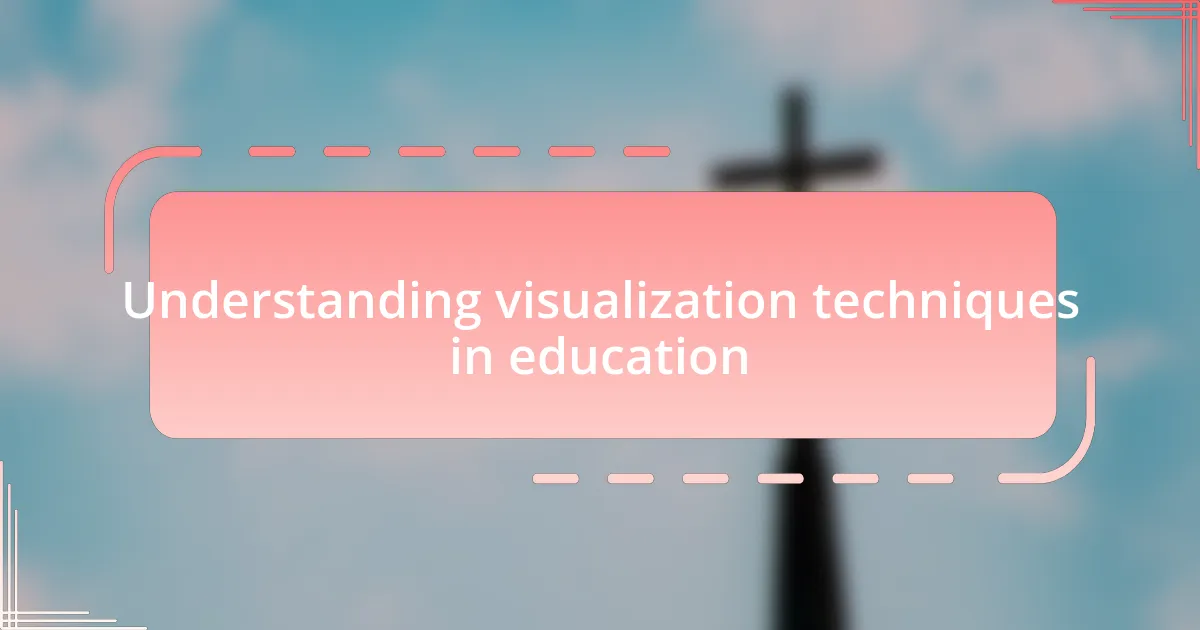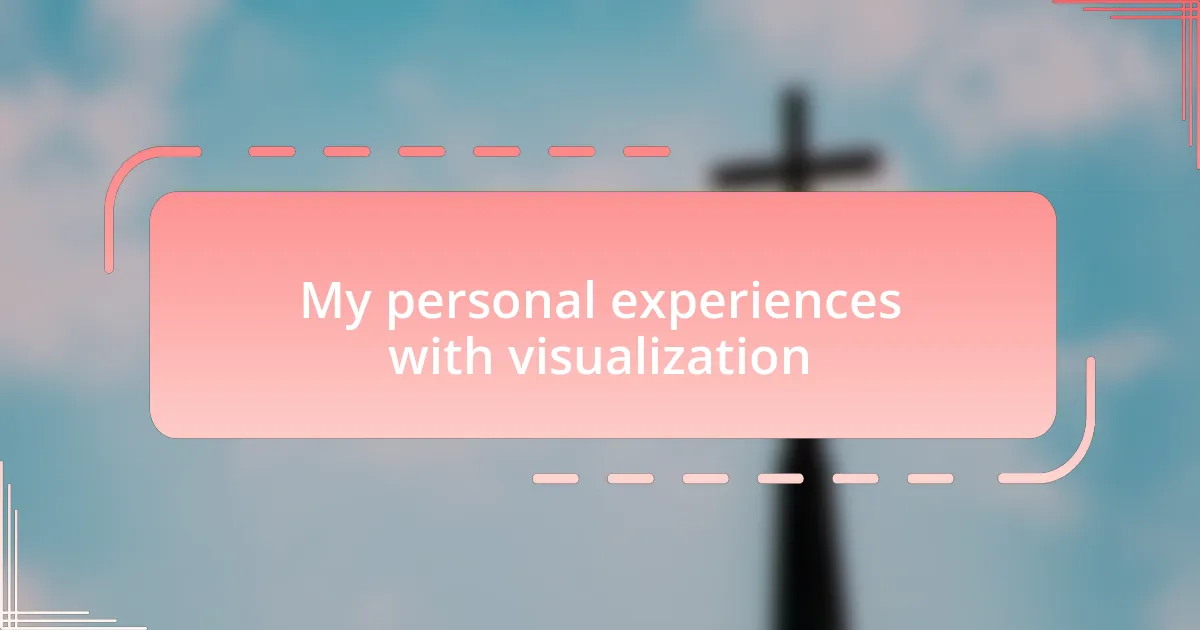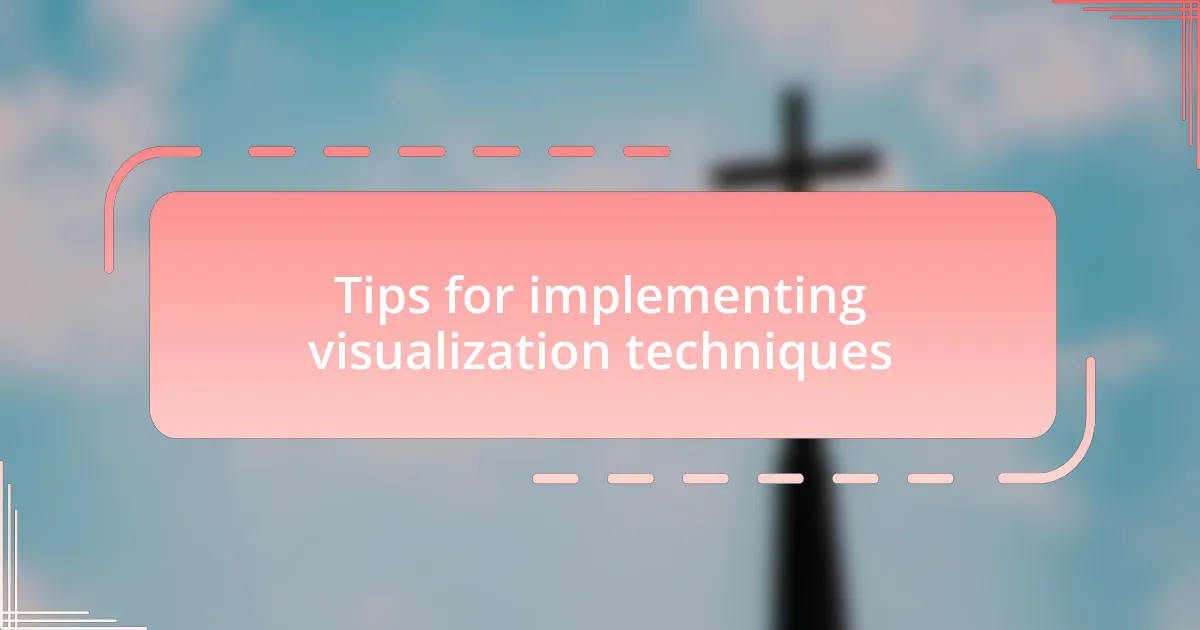Key takeaways:
- Visualization techniques enhance comprehension and retention by making abstract concepts more tangible and interconnected.
- Different techniques, such as mind mapping, storyboarding, and infographics, encourage creativity and enrich student discussions.
- Evaluating the effectiveness of visuals reveals their transformative power in fostering confidence and ownership in student learning.
- Gathering student feedback after using visuals is crucial for adapting and improving teaching methods to better serve their learning needs.

Understanding visualization techniques in education
Visualization techniques in education are essential for enhancing comprehension and retention. When I first encountered mind mapping during a workshop, it transformed the way I approached complex subjects. Suddenly, abstract concepts felt more tangible and interconnected, fostering a deeper understanding of the material.
Interestingly, I’ve found that using visuals can also spark curiosity. For instance, when introducing a new topic, I often ask, “How does this image relate to what we’re learning?” This question invites students to explore their thoughts and perspectives, igniting discussions that lead to richer insights. The emotional engagement that comes from visual aids often makes the learning process more enjoyable and memorable.
In my experience, incorporating infographics or charts can simplify complex ideas. I recall creating a timeline of religious events that turned a dense textbook section into a captivating story. The shift in my students’ focus was palpable; they not only grasped the information but were excited to learn more. Isn’t it fascinating how the right visual can turn learning into an adventure?

Different types of visualization techniques
Visualization techniques come in many forms, each serving different educational purposes. For instance, I often use graphic organizers, like Venn diagrams, to help students compare and contrast key religious beliefs. The process of visually laying out similarities and differences not only clarifies these concepts but also encourages deeper discussions among students. Have you ever noticed how much easier it is to process information when it’s visually represented?
Another technique I’ve found effective is the use of storyboards, which allow students to create visual narratives around religious texts. I once guided a project where students illustrated major events from a sacred scripture. This method encouraged creativity while also deepening their understanding of the content, as they had to think critically about how to visually represent intricate ideas. It’s remarkable how a storyboard can turn a traditional lesson into a vibrant storytelling experience.
Lastly, video content has become an indispensable tool in my teaching arsenal. There was a time when I integrated short documentaries related to religious practices, which opened up a world of rich cultural insights. Watching how beliefs are practiced across different societies sparked a level of curiosity that textbooks alone couldn’t provide. How often do we underestimate the power of sight and sound in making learning relatable and impactful?

My personal experiences with visualization
My journey with visualization techniques began when I experimented with mindfulness drawings during a lesson on the meditative aspects of various religions. I found that asking students to sketch their understanding of peace helped them tap into their emotions in ways that words sometimes couldn’t. Watching them immerse themselves in their artwork was a reminder of how powerful visual expression can be in fostering personal connections to complex spiritual concepts.
One memorable experience was organizing a visual timeline of religious events, where students illustrated key moments in their own lives that resonated with significant religious milestones. The classroom turned into a gallery of personal history, each piece telling a story that intertwined their past with their faith. It made me realize the depth of understanding that can arise when education becomes personal and visually engaging; don’t we all love when our experiences become part of a larger narrative?
I’ve also had my share of challenges. There was a time I introduced infographics to summarize the key ethical teachings of various religions, but many students initially found them overwhelming. I had to step back and guide them through the process, helping them break down information into digestible pieces. I learned that sometimes, the journey towards creating effective visual aids is just as important as the end product; isn’t it fascinating how learning can be a collaborative exploration?

Evaluating the effectiveness of visualization
Evaluating the effectiveness of visualization in religious education can often feel subjective, yet there are clear signs of success. I remember a time when a student wrote to me months after a class, expressing how a simple mind map had helped clarify their thoughts on the interconnectedness of faiths. Their newfound confidence in discussing these concepts was a testament to the transformative power visuals can have. Hasn’t it struck you how a single image can sometimes convey what a hundred words cannot?
In another case, I implemented collaborative visual projects where students created visual representations of ethical dilemmas from their religious perspectives. It was heartening to see them take ownership of their learning. The projects sparked vibrant discussions, allowing students to articulate their beliefs and challenge each other’s viewpoints in ways that traditional lectures could not achieve. Don’t you think this collaborative exploration could lead to deeper understanding and respect among differing beliefs?
Of course, not every visual approach lands successfully. I once used a complex diagram to explain the nuances of religious diversity, but the room filled with confused expressions. Realizing that I needed to simplify, I adapted the visual to focus on broader themes rather than minute details. This experience taught me a valuable lesson: the effectiveness of visual aids hinges on their clarity and relatability. Isn’t it ironic how sometimes, the simplest visuals lead to the most profound understanding?

Tips for implementing visualization techniques
When implementing visualization techniques, start small. I’ve found that even a simple chart can stimulate interest and discussion among students. For example, introducing a basic timeline of religious events created an immediate connection for my learners, inviting them to visualize the historical flow of beliefs. Have you ever noticed how a straightforward visual can transform the way we absorb complex information?
In a classroom project, I encouraged students to create their own visual aids, like posters or infographics, to present different faith traditions. The excitement was palpable as they expressed their individual interpretations. Witnessing their creativity flourish not only reinforced their understanding but also fostered a sense of ownership over their learning journey. Isn’t it amazing how personal expression can deepen engagement in a topic that sometimes feels distant?
Finally, always gather feedback after using visuals. One time, I sought students’ thoughts, and they candidly shared that the vivid images I used during a lesson on religious symbols helped them remember key concepts. This open dialogue with them was enlightening—it highlighted the importance of adapting visuals according to their preferences and experiences. How often do we overlook our audience’s input when refining our teaching methods?